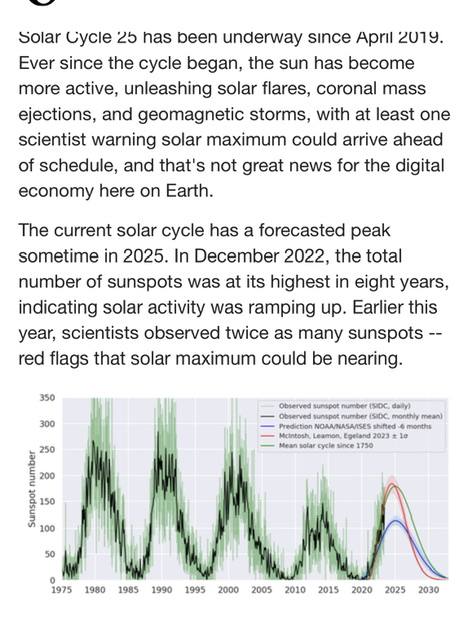Announcement
Collapse
No announcement yet.
Climate Clown Planet
Collapse
Logging in...
Welcome to Agriville! You need to login to post messages in the Agriville chat forums. Please login below.
X
-
 Guest
Guest
Like the “green†wood chip phenomenon?Originally posted by shtferbrains View PostWhat defines a "worthless offset"?
Regional government proclamations are the only guidelines on most grenwashing values.
Some states in the US have declared used tires as OK to burn as biomass.
I guess they may contain some natural rubber thar comes from trees?
Solves the recycling problem with tires that currently amounts to hauling them around to Central storage piles.
They can burn them with the wood pellet from the Co2 harvesting forests they cut down.
Government mandates are the only reason much of this stuff has ANY value.
That's the green economy.
Trillions of our tax dollars to greenwash.
Comment
-
I can't imagine how solar panels on agricultural land is justified. How can choking off the plants that absorb CO2, emit oxygen, and feed the world be a good thing?
Comment
-
 Guest
Guest -
Most of us grow the most efficient solar panels in existence every year …..


That also collect a massive amount of carbon from the air , millions of acres worth .
Comment
-
https://phys.org/news/2023-06-canada-co2-emissions-year.html
Canada sees record CO2 emissions from fires so far this year
by Marlowe HOOD
Wildfires in Canada have generated record CO2 emissions.
Wildfires raging across Canada, made more intense by global warming, have released more planet-warming carbon dioxide in the first six months of 2023 than in any full year on record, EU scientists said Tuesday.
Hundreds of forest fires since early May have generated nearly 600 million metric tons of CO2, equivalent to 88 percent of the country's total greenhouse gas emissions from all sources in 2021, the Copernicus Atmosphere Monitoring Service (CAMS) reported.
More than half of that carbon pollution went up in smoke in June alone.
"The emissions from these wildfires are now the largest annual emissions for Canada in the 21 years of our dataset," CAMS said in a statement.
The previous record for CO2 cast off by wild fires was just over 500 million tons, in 2014.
As of Tuesday, firefighters were battling 494 blazes throughout the country, more than half of them classified as out-of-control, according to the Canadian Interagency Forest Fire Centre.
Fuelled by unusually dry conditions and high temperatures, fires erupted in large numbers starting in early May in the western part of Canada, expanding over the last 50 days eastward to Ontario, Nova Scotia and Quebec.
Globally, forests play a crucial role in curbing global warming by absorbing and stocking excess CO2—emitted mainly from burning fossil fuels—that is overheating the planet.
Canada wildfires: active fires and fire danger.
Vegetation and soil have consistently soaked up about 30 percent of CO2 pollution since 1960, even as those emissions increased by half.
When forests burn, however, all that stored carbon is released into the air.
Fires in eastern Canada have sent huge plumes of particle-filled smoke across the Atlantic Ocean at high altitude, reaching the British Isles and Europe this week.
The long-range transport of smoke by prevailing winds "is not unusual, and not expected to have any significant impact on surface air quality in Europe," said CAMS senior scientist Mark Parrington.
"But it is a clear reflection of the intensity of the fires."
Earlier in June, eye-watering smoke and throat-scratching particle pollution from Canada's fires descended over the US eastern seaboard, including New York City and Philadelphia.
More than 75 million people were under air quality alerts.
Air quality in Montreal was ranked among the worst in the world over the last weekend, according to IQAir.
Worldwide, wildfires in 2021 released about 1.8 billion tons of CO2 into the atmosphere, compared to about 38 billion from fossil fuels and industry.
© 2023 AFP
Comment
-
https://www.ualberta.ca/folio/2023/05/could-growing-crops-under-solar-panels-provide-food-and-energy-at-the-same-time.html
Could growing crops under solar panels provide food and energy at the same time?
Researchers are assessing the potential of agrivoltaics to help tackle two sustainability challenges.
Imagine growing greens in your back yard under a solar panel, and then juicing them in a blender powered by the same energy. A new University of Alberta project is working to make that a reality.
By growing spinach under different solar panels, two U of A researchers are measuring how the process affects both plant growth and the electrical output of the panels.
Known as agrivoltaics, the fairly new sustainable practice integrates solar panels with crops, making simultaneous use of land for both food and energy production.
Agrivoltaics has the potential to address several pressing issues around sustainability, says Guillermo Hernandez Ramirez, an associate professor and soil scientist in the Faculty of Agricultural, Life & Environmental Sciences.
“It brings together major challenges we have ahead of us: the energy transition to renewable energy sources and the questions of feeding the world and addressing issues of climate action,†he says.
Agrivoltaics has other benefits besides dual land use and food security; it could also reduce greenhouse gas emissions and make more efficient use of water.
And it’s scalable to serve both rural and especially urban agriculture, by making use of back yards and city green spaces to grow food and generate electricity, he notes.
That in turn helps people see sustainability as a way of life, Hernandez Ramirez believes.
“It brings this idea of connection. By having agrivoltaics in urban settings, people can experience what it’s like to be able to produce both food and electricity.â€
“We can’t source all the food and energy we need from agrivoltaics, but it makes a contribution, and people can have that context. It builds a sense of caring about where these things are coming from.â€
Win-win for plants and solar panels
The U of A pilot project is an initial step in exploring the potential benefits of agrivoltaics, says research intern Camila Quiroz, who is running the experiment.
“The field hasn’t been researched much, but more knowledge will be necessary in the near future for us to continue living in the world,†she says.
In the 25-day project, conducted in a growth chamber, the researchers compared the growth of spinach plants under three different conditions — with no solar panel or shaded by either a thin or a thick panel — and also measured how much electricity can be harvested from each type of panel.
Agrivoltaics tends to have benefits for both plants and panels, she notes.
“Solar panels have better output with lower temperatures, so by placing the plants under the panels, it creates a cooling effect that helps the panels be more efficient.â€
In turn, leafy plants like spinach and lettuce, along with succulent produce like berries, corn, onions, tomatoes and g****s, need shade to thrive — which the solar panels in this experiment provide.
Early results show promise
The month-long experiment showed promising results, the researchers note.
Under the solar panels, the spinach plants consumed up to 17 per cent less water, and though their growth was slower than without the panels, the plants’ overall health remained high as they neared harvest weight.
“It shows that using agrivoltaics is not detrimental to plant health,†she notes.
The solar panels also generated power output of 10 watts, enough to power electronic devices such as mobile phones, tablets, LED lamps or small appliances.
“This project is a step forward in showing that as we harvest solar energy for use in our homes, for example, we could also be growing nutritious food at the same time,†says Hernandez Ramirez.
Once the project data are fully analyzed, the results will be published in a scientific paper, and Quiroz also plans to produce a how-to guide for the public “so people can start practicing some of these things.â€
Hernandez Ramirez also hopes to share the guide with the City of Edmonton as a useful example of how agrivoltaics could be optimized to the city’s weather conditions.
“This is an example of a very good project that would help the city in its quest to do more sustainable development.â€
Next steps are to secure research funding to further test agrivoltaics with other plants such as berries and more vegetables, explore different angles and arrangements of solar panels and test them in outdoor conditions like rain, he adds.
“Agrivoltaics is a whole new field of research and an option we want to keep exploring and find ways to implement, because it’s a win-win for society and for food and farming industries.â€
Comment
-
-
This is also a great read on historical natural warming and cooling that have been recorded over several thousand years …
https://www.pnas.org/doi/10.1073/pnas.230423297
Comment
-
https://www.theguardian.com/world/2023/jun/29/china-wind-solar-power-global-renewable-energy-leader
China on course to hit wind and solar power target five years ahead of time
Beijing bolstering position as global renewables leader with solar capacity more than rest of world combined
Amy Hawkins and Rachel Cheung
Thu 29 Jun 2023 01.00 BST
Last modified on Thu 29 Jun 2023 02.30 BST
China is shoring up its position as the world leader in renewable power and potentially outpacing its own ambitious energy targets, a report has found.
China is set to double its capacity and produce 1,200 gigawatts of energy through wind and solar power by 2025, reaching its 2030 goal five years ahead of time, according to the report by Global Energy Monitor, a San Francisco-based NGO that tracks operating utility-scale wind and solar farms as well as future projects in the country.
It says that as of the first quarter of the year, China’s utility-scale solar capacity has reached 228GW, more than that of the rest of the world combined. The installations are concentrated in the country’s north and north-west provinces, such as Shanxi, Xinjiang and Hebei.
Solar panels at the Williamsdale solar farm outside Canberra
‘Insanely cheap energy’: how solar power continues to shock the world
In addition, the group identified solar farms under construction that could add another 379GW in prospective capacity, triple that of the US and nearly double that of Europe.
China has also made huge strides in wind capacity: its combined onshore and offshore capacity now surpasses 310GW, double its 2017 level and roughly equivalent to the next top seven countries combined. With new projects in Inner Mongolia, Xinjiang, Gansu and along coastal areas, China is on course to add another 371GW before 2025, increasing the global wind fleet by nearly half.
“This new data provides unrivalled granularity about China’s jaw-dropping surge in solar and wind capacity,†said Dorothy Mei, a project manager at Global Energy Monitor. “As we closely monitor the implementation of prospective projects, this detailed information becomes indispensable in navigating the country’s energy landscape.â€
The findings are in line with previous reports and government data released this year, which predicted that China could easily surpass its target of supplying a third of its power consumption through renewable sources by 2030.
China’s green energy drive is part of its effort to meet dual carbon goals set out in 2020. As the world’s second largest economy, it is the biggest emitter of greenhouse gases and accounts for half of the world’s coal consumption. The Chinese president, Xi Jinping, pledged in 2020 to achieve peak CO2 emissions before 2030 and carbon neutrality by 2060.
The report attributed China’s remarkable progress in expanding its non-fossil energy sources to the range of policies its government has implemented, including generous subsidies to incentivise developers as well as regulations to put pressure on provincial governments and generating companies.
China began operating the world’s largest hybrid solar-hydro power plant in the Tibetan plateau on Sunday. Named Kela, the plant can produce 2bn kW hours of electricity annually, equal to the energy consumption of more than 700,000 households.
Despite China’s careful planning, its energy transition is not without its challenges. In recent years, record heatwaves and drought crippled hydropower stations, resulting in power crunches that brought factories to a halt. An outdated electricity grid and inflexibility in transferring energy between regions add to the uncertainty.
The Kela plant is located in the sparsely populated west of the country, where more than three-quarters of coal, wind and solar power is generated. But the vast majority of energy consumption happens in the east. Transporting energy thousands of miles across the country results in inefficiencies.
The way China’s grid is organised can incentivise building coal plants around renewable generators. Much of the new renewable capacity is not connected to the local energy supply and often bundled with coal power to be transmitted to areas of higher demand.
More coal power was approved in the first three months of 2023 than in the whole of 2021.
“China is making strides,†said Martin Weil, a researcher at Global Energy Monitor and an author of the report. “But with coal still holding sway as the dominant power source, the country needs bolder advancements in energy storage and green technologies for a secure energy futur
Comment
- Reply to this Thread
- Return to Topic List

Comment